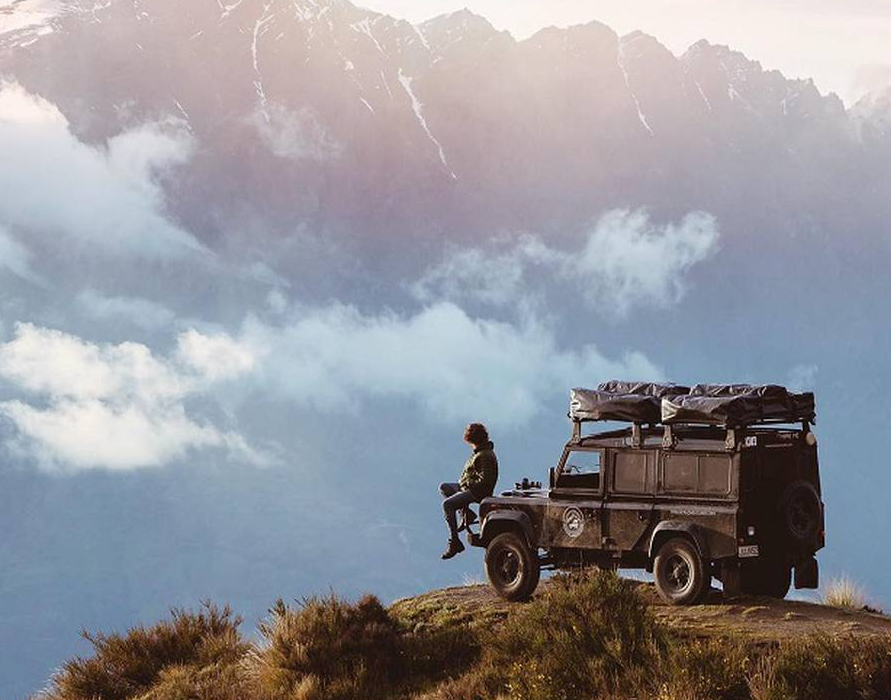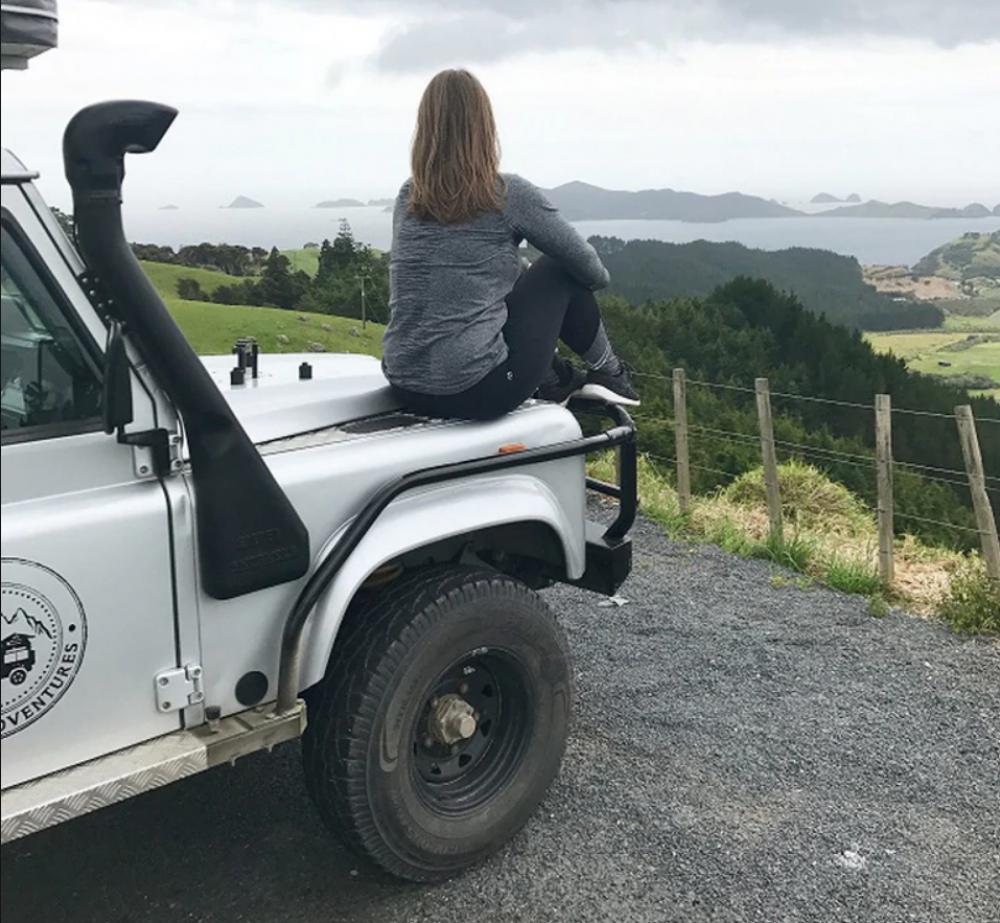
You might also like:
Stephanie Holmes sleeps on the roof in a Bay of Islands getaway weekend.
The first thing most people say when I show them pictures of Stirling, the 4WD
I used over Labour Weekend is “wow, that’s so cool”. The first thing I said when I saw pictures of Stirling was “how do you not fall off?”
For Stirling, along with the other vehicles in Auckland-based rental company Trekker Adventures’ fleet, is not only a grunty-looking rebuilt 1985 Land Rover Defender, it’s also a portable campsite, complete with two pop-up two-person rooftop tents so you can camp anywhere, anyhow; the ideal vehicle for exploring the great Kiwi outdoors this summer.

But in the pictures, things look a little, well, unstable. How do you erect it? And, once up, would this rooftop tent hold the weight of me and my boyfriend – neither of whom could be described as “petite”? Would we survive a long weekend on the road without falling out . . . or falling off?
We pick up Stirling early on the Saturday morning of Labour Weekend, keen to hit the road. Meeting us at Trekker Adventures HQ is owner Bill Neville, the smart cookie who has grown his business from a couple of customised Land Rovers last summer to his current fleet of 15+ vehicles.
Neville, an American in his early 30s, moved to New Zealand with his Kiwi wife and, after a successful career in the pharma industry, decided to “make things a lot more stressful for myself by starting my own business”, just when the couple were having their first baby. He’s a long-time lover of Land Rovers and saw their potential as more than just a great off-road vehicle, but also as a super-cool alternative to a campervan.
Each vehicle is kitted out with its own rooftop tent (or tents), as well as all the gear you’ll need – portable gas barbecue, table and chairs, first aid kit, cutlery, utensils, pots and pans, mattress and ladder. Neville recognises that many of his customers will be travellers arriving in the country with just their backpacks – he wants to supply them with everything they’ll need to step off the plane and hit the road running.
After a quick rundown of how the tent works (you basically just unzip the cover, pull down the ladder and the tent pops up on a cantilever system – easy as), Nathan and I are off on our way up north, excitement fizzing between us at the potential for adventure ahead.
Stirling – so named for its shiny silver bodywork – purrs as we cross the harbour bridge and follow State Highway One. The weather is drab and drizzly but we’re feeling great, the mood helped by my Spotify roadtrip playlist blasting through Stirling’s stereo, connected via USB. Neville has made sure to kit out all the vehicles with multiple USB ports so travellers have plenty of options for recharging smartphones and cameras – all the better for frequent posting of wanderlust-inspiring photos on social media.

As we drive, we collect admiring looks from passersby and I have to admit, Stirling does look damn cool. As we get close to the Bay of Islands, we get the first opportunity to see what he’s really made of as we turn on to the gravel road that will take us to Russell and a much-needed refreshment break at the historic Duke of Marlborough. He handles it like a dream, and Nathan is in his element behind the wheel; Stirling is quite the change for a man used to driving a tiny Holden Barina.
The waterfront restaurant is humming on this busy Saturday, with Kiwis celebrating the first long weekend of the summer season. The weather didn’t get the memo, however; it’s cold and windy as we drive up Flagstaff Hill for a 360-degree view over Russell and across to Paihia. I’m starting to worry I’ll freeze to death in our rooftop tent overnight.
As the afternoon wanes we reach Kerikeri, our final destination, and make a pitstop at Marsden Estate for some late-afternoon wine-tasting. This family-owned-and-run winery, just outside Kerikeri town centre, would be easy to pass by as it looks quite unassuming from the road. But do stop in – through the heavy wooden doors, you’ll find a large restaurant and outdoor terrace, overlooking a beautiful garden, man-made lake and hills of rolling vines – a tranquil spot for a long summer lunch.
The wines are delicious too – $7 per person gives you the chance to sample everything on the menu. If you buy a bottle, the fee is waived. We taste our way through a handful of varietals and leave with bottles of our favourites – the 2016 chardonnay and the 2014 chambourcin – which we plan to enjoy over our first campsite dinner.
Although Stirling is the ideal vehicle for freedom camping at some remote spot along the Northland coast, we’ve decided to play it safe for our first adventure and have booked a site at Aroha Island, an eco-sanctuary about 15 minutes from Kerikeri’s town centre.
Voted one of New Zealand’s six best campsites by Kathmandu last year, Aroha Island has waterfront campsites, excellent facilities and is home to two resident kiwi, which visitors can attempt to spot at night.
As we drive up the gravel road and find our site, we’re pleased with our choice. The outlook is stunning, across the estuary back to Kerikeri in front of us and thick native woodland behind.
Now comes the moment of truth – can we put up our tent in the 10 minutes Neville told us it would take to set up?
The first bit is relatively easy – unzipping the cover, pulling down the ladder, and the tent folds out almost fully-formed just as he said it would. Getting the poles into the window rain shades is slightly trickier but, in all, the tent is erected in less than 20 minutes. Not bad for a first attempt.

It’s also causing quite a stir around the campground, with admiring glances from our neighbours, one of whom tells me he’s going to nominate us for Grand Designs. If only we could take the credit.
After a delicious barbecue dinner of steak and veges, and a little bit tipsy on Marsden Estate chambourcin, we venture out into the dark to see if we can find Harry and Henrietta, Aroha Island’s resident kiwi. As quietly as we can, we pad through the night along the bush trails, stopping every time we hear a rustle in the undergrowth, turning off our torch (covered with red cellophane so as not to scare the kiwis who are sensitive to light).
It’s like an exercise in mindfulness, taking care with every step, concentrating hard on all the sounds around us, and thinking of nothing but the search for kiwi.
Luck isn’t on our side, but others fare better – an American family say they saw the red-tagged leg of one kiwi, just ahead of us on the track. We decide to retire for the night and give it another go tomorrow.
The second moment of truth – will we get a good night’s sleep on top of a van? Well, although I find myself awake much of the night, I can’t blame it on the tent setup. It’s sturdy, warm, dry and comfortable. My problem is the mosquitoes who find me irresistible wherever I go, the need to climb down the ladder and find my way to the toilet block in the middle of the night, and the noises from the bush surrounding us – the squeals of the kiwi that proved so elusive for us, and the snores drifting up from the other tents around us. Nathan sleeps like a log.
Morning arrives and we pack up the tent to venture off again. We decide to spend the day following our nose and filling our stomachs. After breakfast cooked on the barbecue, we make a quick stop at the Bay of Islands farmers market in Kerikeri where we fall in love with the Ikarus coffee, the pulled pork roll from Winged Angel, and the huge bags of organic avocados for $5.
We make our way along the coast, stopping occasionally for photo opportunities and to admire the stunning views – Matauri Bay, and the Rainbow Warrior memorial, looking to the Cavalli Islands; Parua, Whau, Wainui and Mahinepua Bays; a stop at Mangonui to buy smoked fish from the world-famous fish and chip shop.
We end up on the Karikari Peninsula, a remote stretch of land with incredible beaches, most of which are deserted, and we stretch our legs at Whatuwhiwhi. When we arrive there are just a few hardy spear fishermen putting on wetsuits before heading out to sea.
Once we pass them we have the whole beach to ourselves – a curving horseshoe of golden sand tinged with pinks and greens, clear blue waters, red tipped toi toi and flax-lined sand dunes.
It’s getting busier as the sun breaks through the clouds; some girls are even braving the frigid waters. A family plays beach cricket and we watch for a while; I think how lucky we all are to have this country as our playground.
That night, the heavens open but we’re warm and dry in our rooftop tent. My dreams are full of the sounds of Kiwi summers – the frenetic chirp of cicadas; the thwack of cricket ball on bat; raindrops on canvas; the steady unzipping of tents in the early morning. Plus a new sound which will now always remind me of great New Zealand adventures – the roar of a Land Rover Defender engine as we hit the open road.
FACT BOX
Getting there
Trekker Adventures
- prices start from $190 per night
Source: nzherald.co.nz
